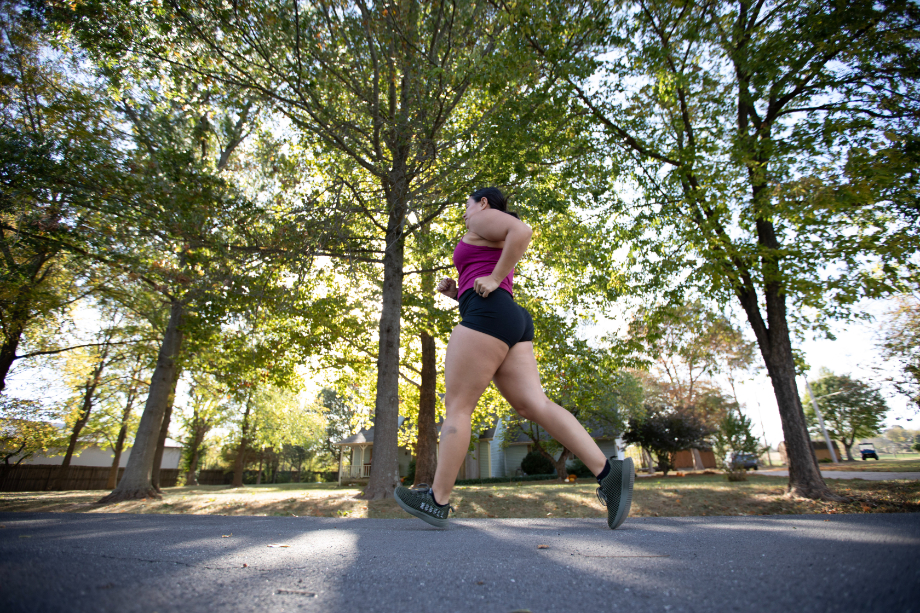We test and review fitness products based on an independent, multi-point methodology. If you use our links to purchase something, we may earn a commission. Read our disclosures.
There are a lot of acronyms out there in the fitness world, like ROM, PR, and of course, HIIT, but have you heard about LISS cardio?
LISS cardio might sound like the new kid on the block due to its name. However, the activities included in this exercise method have been around for quite some time. In fact, if you work out now, it’s very possible that you’re already doing LISS cardio, and for those who aren’t, you’re in luck!
If you’re someone who doesn’t quite like the “high” intensity in HIIT and wants to incorporate slower aerobic activities that still get results, you’ll like LISS cardio. Keep reading to learn what LISS cardio is all about, how it stacks up next to HIIT, and other frequently asked questions.
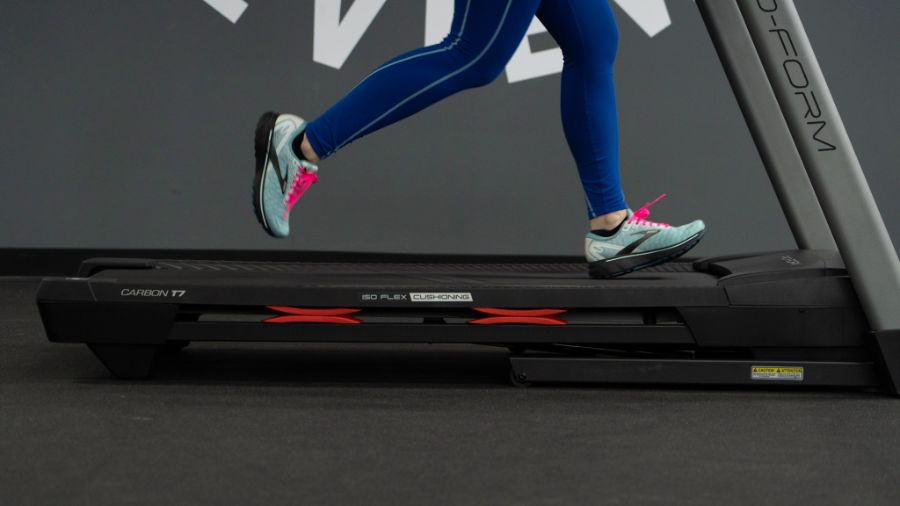
What Is LISS Cardio?
LISS cardio is a newer buzzword that stands for “low-intensity steady state training,” but it also goes by other names. Since it’s technically been around for decades, you may hear some individuals refer to it as steady-state training, low-intensity exercise, continuous cardiovascular exercise, or long, slow distance training.
This method of cardiovascular exercise entails performing an aerobic activity at a low-to-moderate pace for an extended period of time. This is the exact opposite of HIIT, or high-intensity interval training, which requires you to alternate short bursts of really intense exercise with low-intensity recovery periods. Although HIIT workouts might help you burn more calories in less time, they may also increase your risk of injury and ultimately demotivate you.
Just in case you’re not sure what we mean, consider this: The target heart rate zone of a high-intensity interval training workout is 80 to 90 percent of your maximum heart rate. As you might imagine, that’s quite a bit, especially if you’re just starting out. In fact, working out near your maximum heart rate can be dangerous if you’re a beginner or have certain health conditions. As a result, it’s recommended that you speak with a medical professional before starting HIIT.
Fortunately, LISS cardio isn’t nearly as strenuous. The goal of a LISS cardio workout is to keep your heart rate around 50 and 65 percent of your maximum heart rate. For many people, this is much more manageable and easier to start.
What Makes LISS Cardio What It Is?
At this point, you’re probably wondering what types of exercises would fit into the LISS cardio category. The good news is that there are many types of LISS workouts, which means you should never get bored with them. But first, let’s break down exactly what makes a LISS workout what it is.
The L and I in LISS stand for low intensity, but what does that mean? For a workout to be considered low intensity means that it doesn’t elevate your heart rate beyond a comfortable level. However, you must remember that everyone’s comfort level is different. You may be comfortable jogging and talking at the same time, while someone else becomes winded while walking and talking on a track. You have to figure out what “comfortable” means for you.
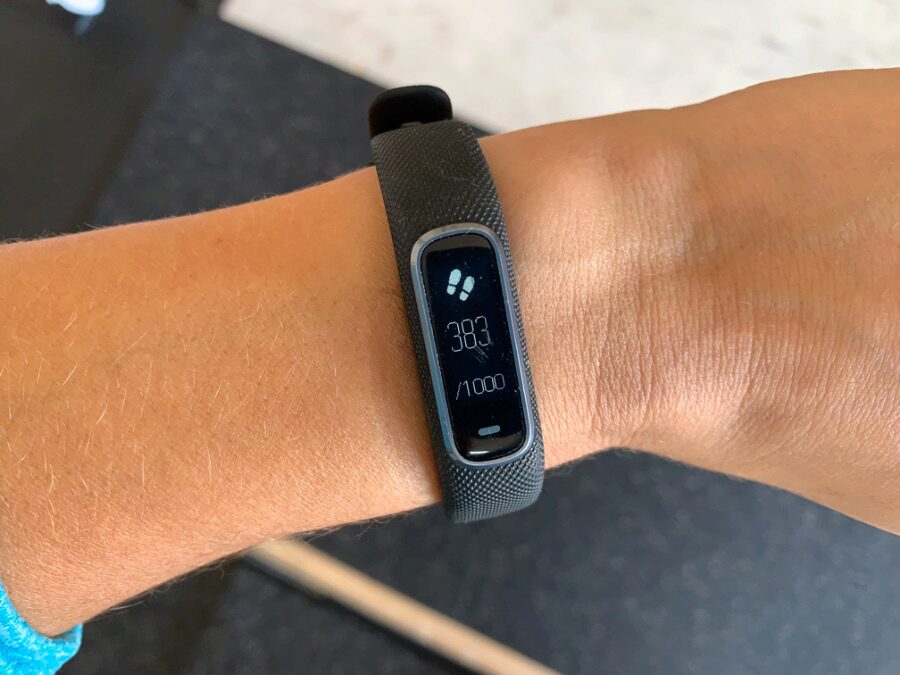
Steady-state, which is the two S’s part of LISS, means keeping your moderately elevated heart rate at that same level for the entire exercise. Therefore, you must be careful not to add dramatic spikes to your workout mistakenly. As a result, heading for a walk in an area with lots of hills may not classify as a LISS workout since that wouldn’t be considered a steady state if those hills cause drastic spikes in your heart rate.
The Different Types of LISS Exercises
Are you almost convinced that you want to add LISS cardio to your training program? You’ll be glad to know that you can do LISS cardio practically anywhere: in the comforts of your home, at the gym, at the park, or somewhere along a trail. Therefore, without further ado, here are some LISS workouts you can incorporate into your routine:
- Hiking
- Indoor cycling
- Leisurely outdoor bike ride
- Walking
- Swimming
- Slow jogging
- Low-impact elliptical workouts
- Treadmill walking
The Health Benefits of LISS
At this point, you know what LISS cardio is and some of the exercises associated with it, but how does it benefit you? According to The Centers for Disease Control and Prevention, any amount of moderate-to-vigorous physical activity is beneficial, and LISS cardio happens to fall in that moderate category. An activity is considered moderate-intensity if you can talk while doing it but not sing. Therefore, activities like bicycling on flat terrain and walking briskly (both LISS exercises) fall in that realm.
Here are some of the benefits of LISS you ought to know about.
1. Reduced Risk of Cardiovascular Disease
Did you know that heart disease and stroke are two leading causes of death in the United States? Unfortunately, almost 900,000 people per year die from these conditions, but there’s something we can do to reduce our risk. Doing just 150 minutes per week of moderate-intensity activities, like LISS cardio, can put you at a lower risk of developing these conditions.
2. Reduced Risk of Type 2 Diabetes
Diabetes is another nationwide public health issue that could be reduced with moderate physical activity. According to one study, physical activity can improve your blood glucose levels and potentially prevent or delay type 2 diabetes. Interestingly enough, these benefits can even be seen without meeting the recommended 150 minutes per week of moderate-intensity exercise. In other words, it’s essential to just get moving!
3. Lose and Maintain Your Weight
By doing LISS cardio, your body will be more capable of using fat as fuel instead of using the glycogen in your muscles. Therefore, it should enhance your ability to burn fat. In fact, one study found that lower intensity, steady-state training is more effective at improving fat distribution than high-intensity interval training.
4. Mental Benefits of LISS Cardio
We often focus on the physical benefits of exercise, but there are some other benefits too. According to the Anxiety and Depression Association of America, aerobic exercise can reduce tension, improve sleep, elevate your mood, and reduce rates of anxiety and depression.
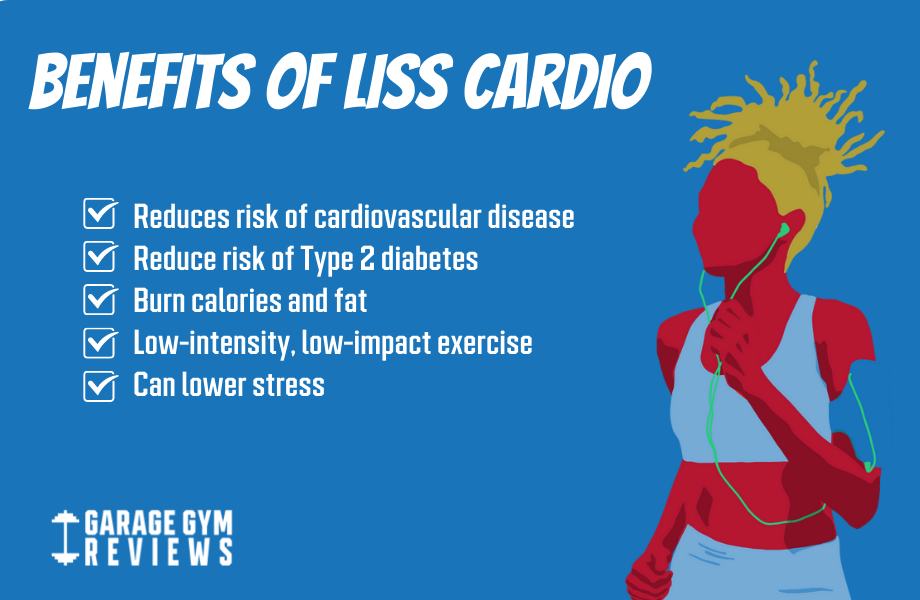
Who Should Do LISS Cardio?
The amazing thing about LISS cardio is that practically anyone can add it to their exercise routine. So whether you’re a beginner or an athlete, this form of training will significantly benefit you.
LISS cardio is a good idea if you’re new to working out and have time to dedicate to it. You can just start with brisk walks and work your way up to more intense workouts. Those with more advanced fitness levels can use LISS as a recovery session after a day of HIIT.
How Often Should I Do LISS Cardio?
How often you do LISS training ultimately depends on where you are on your fitness journey and your goals. Beginners may probably start off doing two to three LISS workout sessions per week. If you’re more advanced, add one or two LISS cardio sessions to your weekly schedule and let them act as your active recovery or rest days.
LISS vs. HIIT
So, should you opt for LISS cardio or HIIT? The best way to determine that is by knowing the pros and cons of each.
“You hear a lot about HIIT nowadays, but don’t be fooled—low-intensity steady-state cardio is still beneficial!” says Nicole Davis, a certified personal trainer and editor at Garage Gym Reviews. “LISS can help improve important health markers like blood pressure and your body mass index, plus increase your aerobic capacity and heart health overall. It’s also great for beginners, and it tends to be lower-impact than high-intensity workouts.”
Now, take a look at the chart below to see how LISS cardio and HIIT workouts really compare to one another.
| Pros of LISS Cardio | Cons of LISS Cardio |
|---|---|
| Easier form of exercise | Can take a large amount of time |
| Great for beginners | You may get bored easily |
| Doesn’t overstress your body | More challenging to maintain lean muscle mass |
| Faster recovery | Increased risk of overuse injuries |
| Pros of HIIT | Cons of HIIT |
|---|---|
| Very efficient for busy individuals | Higher risk of injury |
| Burn fat quickly | Not suitable for everyone |
| Improves endurance | Longer recovery time |
| Can do anywhere | May stress the nervous system due to the release of excess cortisol |
LISS Cardio Workouts
Not sure what kind of LISS cardio exercises you can do? Not to worry, because we’ve got you covered. Before you get started though, make sure you grab a heart rate monitor, like a fitness tracker. This will ensure you’re keeping your heart rate around 50 and 65 percent of your max heart rate.
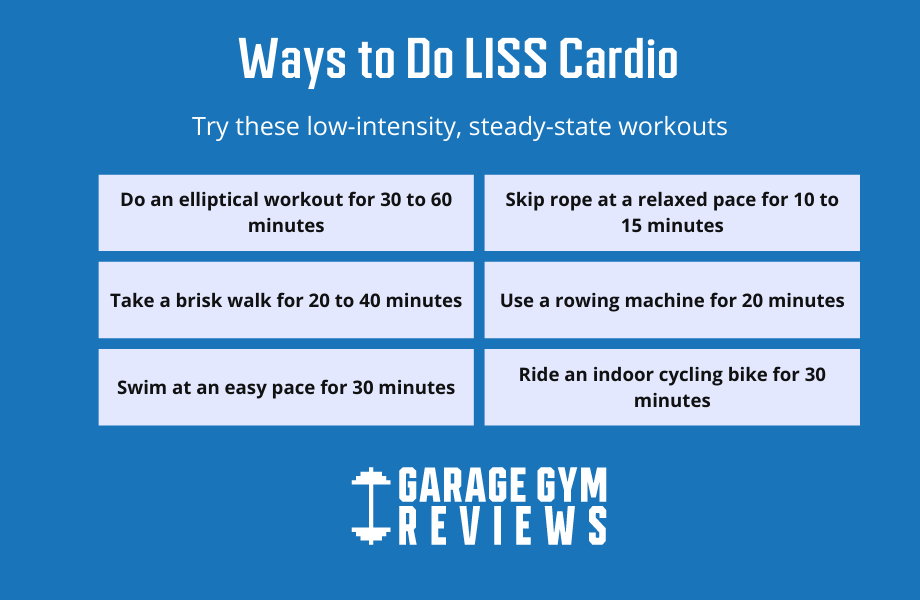
Here are a few ideas you can try today:
- Elliptical Workout: Set it to a steady pace and keep going for 30 to 60 minutes.
- Brisk Walk (with or without weights): Head outdoors and walk two miles for 30 minutes. If you’d like to take it up a notch, use a weighted vest or backpack to add 20 pounds more.
- Swimming: Burn around 300 calories in 30 minutes by doing the freestyle, backstroke, or breaststroke.
- Jump Rope: Take just 10 to 15 minutes to skip rope.
“An accessible way to do LISS is to go for a walk—aiming for at least 7,000 steps per day to greatly decrease mortality rates,” says Nicole. “Plus it adds to your non-exercise activity thermogenesis (NEAT) value, which is an important contributor in weight management.”
FAQs About LISS Cardio
Can You Lose Weight Doing LISS Cardio?
Yes, if you’re looking to lose weight, you can certainly do so with LISS cardio. It does help you lose fat, so if you combine that with eating fewer calories, you’ll lose weight. The Centers of Disease Control and Prevention state that 150 minutes of moderate-intensity aerobic exercise per week can help you maintain your weight, so you may need to work out more than that to experience weight loss and also keep it off.
Also, LISS doesn’t have to be the only form of cardio or form of exercise you incorporate to lose weight. If you feel comfortable, add in strength training or sprinting for additional fat burning and fat loss.
Is LISS or HIIT better?
People like to automatically claim that one form of activity is better than the other, but both are good for different reasons. If you’re new to working out or trying to build your endurance, LISS is likely the best approach for you. However, if you crave a variety of workouts and are short on time, HIIT is probably the answer for you. Overall, it all comes down to what your goals and circumstances are.
VO2 Max Calculator
We created our own VO2 max calculator so you can estimate your cardiovascular fitness level.
Further reading

Choosing the right pre-workout can be overwhelming, so we’ve rounded up the 14 best pre-workouts on the market today to help you find the right product for your performance goals. Read more

There are a lot of acronyms out there in the fitness world, like ROM, PR, and of course, HIIT, but have you heard about LISS cardio? LISS cardio might sound like the new kid on the block due to its name. However, the activities included in this exercise method have been around for quite some time. In fact, if you work out now, it’s very possible that you’re already doing LISS cardio, » Read more about: An Expert’s Guide to LISS Cardio: When and How to Do It » Read more

There are a lot of acronyms out there in the fitness world, like ROM, PR, and of course, HIIT, but have you heard about LISS cardio? LISS cardio might sound like the new kid on the block due to its name. However, the activities included in this exercise method have been around for quite some time. In fact, if you work out now, it’s very possible that you’re already doing LISS cardio, » Read more about: An Expert’s Guide to LISS Cardio: When and How to Do It » Read more

The Rogue RML-90SLIM Rackis the most compact and best-priced squat rack that Rogue Fitness makes. It’s an extremely simple rack that is designed for the budget-conscious and space-restrained, yet offers most of the functionality of a standard squat stand with a pull-up bar while sitting only 16” from the wall. After testing and reviewing the RML-90SLIM, we recommend it highly and actually think it’s one of the best squat racksfrom Rogue to date. Read more

